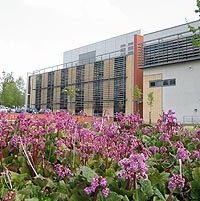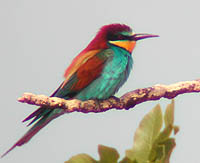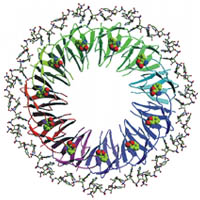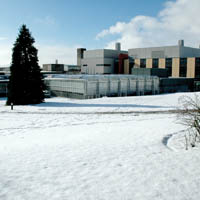



York Biology Open Lecture Series
Past Lectures
27 Jan 2010, P/X/001, 12.15 PM
Professor Sir Alec J. Jeffreys, University of Leicester
Genetic fingerprinting and beyond
DNA fingerprinting, accidentally invented in 1984, has revolutionised many areas of biology, most notably forensic and legal medicine. I will describe how DNA typing can be used to solve casework and will review the latest developments, including the creation of major national DNA databases that are proving extraordinarily effective in the fight against crime. I will also discuss how this work led to the discovery of some of the most unstable regions of human DNA, and how these in turn have opened the way to exploring the fundamental processes of mutation and recombination that generate all human DNA diversity.
* * * * * *
24 Feb 2010, P/X/001, 12.15 PM
Professor Alison Smith, OBE, John Innes Centre, Norwich
How Plants Survive the Night
Plants have the unique ability to make their own food directly from carbon dioxide in the air. The process of photosynthesis in leaves converts carbon dioxide into sugars, which plants use for their growth. But photosynthesis requires light, and plants live only half of their lives in the light. How do they ensure that they don’t starve during the night? I will talk about the remarkable processes in the leaf that ensure a constant supply of sugars for growth in darkness. The leaf manufactures solid, crystalline starch granules from sugars during the day, then releases sugars from these granules at night. To prevent starvation, the release of sugars must continue throughout the night, until dawn when photosynthesis can resume. The plant achieves this by using an internal 24-h clock to measure time. Whenever it gets dark, the plant can “anticipate” accurately when the next dawn will come and adjust the release of sugars so the supply lasts until that point.
* * * * * *
3 March 2010, P/X/001, 12.15 PM
Dr Armand M. Leroi, Imperial College London
Aristotle & the Worm
Why do creatures grow as big as they do, have as many offspring as they do, live as long as they do? These are all quintessentially Darwinian questions and for decades evolutionary biologists have considered them under the rubric of the “evolution of life-history”. However, I shall argue that if, in the 21st century, we want to understand life-history we should take inspiration from another great biologist as well: Aristotle. For, unlike Darwin, Aristotle was deeply interested in the mechanisms that shape life histories – the flows of information and materials that control the lives of animals. In recent years we have learnt much about these mechanisms through the study of model organisms such as the fly, Drosophila, and the worm, C. elegans. I shall outline a little of what we have learnt – and, perhaps, what we need to know.
* * * * * *
2 Dec 2009, P/X/001, 12.15 PM
Professor Sir David Baulcombe FRS, University of Cambridge
Of Maize and Men or Peas and People: the Value of Plants as Model Systems in Molecular Biology
There are many examples of fundamental discoveries in biology that were made first in plants. Hooke’s first description of cells, Mendels laws of genetics and McClintock’s transposable elements of DNA are particularly notable examples. More recently a class of small regulatory RNA that is common to many eukaryotes was first discovered in plants. These small RNAs have been referred to as the dark matter of genetics because they are abundant and recently discovered. Some of these small RNAs are negative regulators of gene expression whereas others participate in more complex regulatory effects or as part of an RNA signal that moves between cells. I will describe how discovery of these small RNAs has opened up new opportunities for the treatment and diagnosis of disease in people and in animals and for improvement of crop plants.
* * * * * *
11 Nov 2009, P/X/001, 12.15 PM
Professor Peter Cox, University of Exeter
Climate Change and Biology: is the Land Biosphere About to Turn Against Us?
The land biosphere performs vitally important roles in the Earth’s climate system, including making the climate more tolerable for humans. Vegetation enhances the recycling of rainfall as evapotranspiration, which helps to cool the tropical landmasses, and generally makes the land-surface darker, which acts to keep the snow-covered high northern latitudes warmer than they would otherwise be. Furthermore, soils and vegetation have been helping to slow-down global warming by absorbing about a quarter of human carbon dioxide emissions (this is the so-called “land carbon sink”).
However the terrestrial biosphere is also strongly influenced by climate. The distribution of vegetation across the globe is largely determined by the major rainfall bands, while the amount of carbon retained in the soil is sensitive to soil temperature and soil moisture. As a result, global warming is likely to impact significantly on the terrestrial biosphere, which will in turn feed-back on to climate change. In regions where the land-climate feedback is especially strong we may even see “tipping points” beyond which the state of the coupled system could change abruptly and irreversibly.
This presentation will discuss feedbacks and tipping points in the response of the land biosphere to climate change, focussing particularly on the possibility of an acceleration of climate change through the failure of the land carbon sink, and instability of soil carbon under global warming and local biochemical heating.
* * * * * *
28 Oct 2009, P/X/001, 12.15 PM
Professor Hugh Pennington, University of Aberdeen
Learning lessons is hard; making predictions difficult
Professor Pennington will cover E.coli O157 outbreaks and influenza pandemics as the main examples of microbial health threats; He will discuss explanations for these in terms of evolution and the ungenerosity of history.
* * * * * *
24 June 2009, P/X/001, 12.15 PM
Professor Janis Antonovics, University of Virginia, USA
Linnaeus and the development of the germ theory of disease
Linnaeus realized, 100 years before Pasteur's confirmation of the "germ theory", that living organisms could cause disease. I will trace the history of Linnaeus' understanding of disease causation, and place this in the context of his work as a physician and a systematist.
* * * * * *
20 May 2009, P/X/001, 13.15 PM
Professor Joanne Webster, Imperial College, London
Neglected Tropical Diseases: Kill or Cure?
Schistosomiasis is a disease of profound clinical and economic importance. It is one of 14 neglected tropical diseases, which combined represent the most common infections of the world's poorest people. These diseases can not only kill but also promote poverty, stigmatise, blind, disable and inhibit individuals for being able to care for themselves or their families. Yet many of these diseases are preventable and/or treatable with currently available safe and effective drugs, for as little as 25 pence per person per year. Focusing upon our work with the Schistosomiasis Control Initiative (SCI), this talk will cover recent 'pro-poor' health interventions aimed towards sustainable treatment and protection of populations within sub-Saharan Africa against the debilitating and life-threatening consequences of these diseases.
* * * * * *
11 March 2009, P/X/001, 12.15 PM
Dr Angela Karp, Rothamsted Research, UK
Bioenergy crops for the UK - challenges and impacts
Bioenergy is currently a hot topic of debate, particularly around the use of food crops for biofuels. There is less awareness that perennial biomass crops (fast-growing trees and grasses) provide a renewable source of energy, with few agrochemical inputs, give higher energy gains and also have a positive impact on climate change by helping to reduce greenhouse gases. This talk will describe research aimed at improving biomass crops for bioenergy and biofuels, focussing on willow, and how we are investigating possible impacts of increasing land area under biomass trees and grasses so that environmental benefits can be optimised.
* * * * * *
18 February 2009, P/X/001, 12.15 PM
Prof Dianna Bowles, University of York
Biology to Benefit Society
We are all living on ancient sunlight - the fossil reserves that once were living organisms, capturing the sun's energy to power their existence many millions of years ago. There are evermore challenges arising from a global economy based largely on oil and a world population that is increasing as productive land and fresh water are decreasing.
The lecture will introduce the opportunities and benefits that can arise if society moves towards a bio-economy, using the sunlight of today and tomorrow and the manufacturing capacity of the plant production system, whether in water or on land.
A robust evidence-base is essential to underpin policy and change during the transition from an oil economy to a bio-economy. The social responsibility of scientists to provide valid evidence, and use their creativity to problem-solve will be discussed. Many solutions to society's problems have already evolved in the natural world: as biologists we can explore that world and realise the full potential offered by the sunlight of today and tomorrow.
* * * * * *
11 February 2009, P/X/001, 12.15 PM
Prof Judy Armitage, University of Oxford
Changing gear: The structure and function of the bacterial rotary motor- a remarkable nanomachine
Relative to their size, bacteria are the fastest living organism on earth. These organisms, usually about 3(mu)m in length, can swim through their environment at tens of body lengths a second. They do this despite being so small that they experience no inertia, only viscosity-indeed their world is so relatively viscous that when they stop swimming they stop within the diameter of a hydrogen ion. This amazing feat is achieved through a remarkable swimming system, a rotary motor linked to a rigid extracellular helix, the flagellum. The flagella motor is the most complex structure in a bacterial cell, composed of multiple copies of over 20 proteins and the product of over 50 genes. It spans the inner and outer membranes and rotates at between 100 and 1300Hz, depending on the driving force. The 45nm structure has all the components expected of a motor: a ring of stator proteins, through which the driving ions move, and an inner rotor. As ions move through the stators they change their interactions with the rotor to drive rotation, to drive rotation of the helical filament. An intracellular sensory system controls the direction of rotation, to move bacteria to their optimum environment for growth.
The apparent completeness of the flagellar motor, and its ability to switch rotational direction has made it the target of researchers involved in 'synthetic biology', with an aim of isolating the motors and using ion driven movement to target engineered minimal bacteria to specific environments-perhaps delivering toxic antibiotics to target cells. Using state of the art microscopy combined with classical biochemistry and molecular genetics, we have been able to study the assembly and operation of motors in living bacterial cells. In this talk I will present surprising data that suggest our image of the flagellar motor is simplistic and the structure is much more complex and dynamic than we ever imagined.
* * * * * *
4 February 2009, P/X/001, 12.15 PM
Prof Chris Higgins FRSA, University of Durham
Stem cells: promise or prejudice?
Stem cells have been hailed as a revolution in medicine. The use of stem cells is also condemned by some as unworkable, unethical or worse. The truth lies somewhere in between. The science, medicine and ethics of stem cells will be discussed. There is no doubt that stem cells will provide effective treatments for currently incurable diseases, although perhaps not as quickly or as cheaply as some have suggested. There is also no doubt that the ethical objections of a minority, while deeply held, are often based on misunderstanding. What is important is that we have very well argued legislation in the UK which regulates stem cell research, and that real progress is being made towards exploiting stem cells for medical benefit.
* * * * * *
19 Nov 2008, P/X/001, 12.15 PM
Professor David Fowler, CEH Edinburgh
The changing chemical composition of the atmosphere over the UK, 1970 - 2008, and implications for effects on terrestrial ecosystems: great improvements and even greater surprises
Since the peak in UK sulphur and nitrogen oxides emissions in the 1970s, emissions have declined by 90% and 50 % respectively, delivering substantial improvements in air quality, not least in the industrial north of England. However, the changing chemical composition of the air has modified many of the processes responsible for transforming the pollutants within and removing them from the atmosphere. These changes have greatly modified the lifetimes, travel distances and footprints for effects on terrestrial ecosystems and human health of the pollutants. The lecture presents the observed changes in UK atmospheric composition, describes the changing processing of the pollutants in the atmosphere and some of the ecological consequences. In particular how is it that emissions of oxidized nitrogen have declined by 50% since the peak, yet deposition to the UK landscape has not changed?; and why does this matter for plant biodiversity and carbon sequestration in the UK?
* * * * * *
7 May 2008, Biology K018, 1.15 PM
Robert Brown (Head of Centre for Regeneration Science, UCL)
While-u-wait Customised Tissue Fabrication: Towards Wallace & Gromit Machines
http://www.ucl.ac.uk/orthopaedics/centres/rbrown.htm
In recent years, the prospect of tissue engineering has stirred public hopes that culture of tissue-forming cells within suitably shaped 3D materials could produce new, functional tissues to replace bodily decay and damage. Professor Brown will describe recent advances in engineering truly biological materials which are taking us in a new and surprising directions. Through these approaches we can now, in principle, fabricate living simple tissues in a huge variety of forms and functions. The current demonstration device looks like a Wallace and Gromit machine - but by producing tissues in minutes it may yet surpass the early dream; producing bespoke tissues at the bedside.
* * * * * *
30 April 2008, Biology K018, 1.15 PM
Douglas Young (Centre for Molecular Microbiology and Infection, Imperial College)
Tuberculosis: A Grand Challenge in Global Health
http://www3.imperial.ac.uk/cmmi/research/young
In spite of the post-war success of control programmes in industrialised
countries, TB remains a major threat to global health. Recent research
on fundamental molecular and cellular aspects of the TB point the way
towards new drugs and vaccines for disease control, and provide insights
into the way that this persistent bacterial pathogen has coevolved with
human society.
* * * * * *
5 March 2008, Physics P/X001, 12.15 PM
Ian Alexander (Chair of Botany, University of Aberdeen)
The distribution of ectomycorrhizal fungi in space and time
http://www.abdn.ac.uk/biologicalsci/staff/details.php?id=i.alexander&filt=
Symbiotic ectomycorrhizal fungi play a central role in nutrient and
carbon cycling in forest and woodland ecosystems, particularly those of
the north temperate and boreal zone. Many people will know of them from
their colourful toadstools, which appear in woods in autumn; but
belowground they exist in complex, species-rich assemblages of colonised
roots and soil mycelium. Molecular techniques allow us to visualise
these belowground communities, and to ask how they are structured, how
the distribution patterns change over time from a few weeks to hundreds
of years, and whether those colourful toadstools are, in fact, any
indication of what is going on belowground.
* * * * * *
20 February 2008, Physics P/X001, 12.15 PM
Marian Dawkins (Professor of Animal Behaviour, University of Oxford)
The scientific basis for animal welfare
http://users.ox.ac.uk/~snikwad/index.html
Can there be a scientific basis for the study of animal welfare? Can we know what emotions other species have? Professor Dawkins will address these issues and argue that the 'two questions' approach provides a pragmatic, evidence-based way of assessing animal welfare in practice. The two questions are: (i) are the animals healthy? And (ii) do the animals have what they want? She will describe some new collective behaviour approaches for studying animal welfare in one of the places where there is most public concern - namely on intensive commercial farms.
* * * * * *
6 February 2008, Physics P/X001, 12.15 PM
Mike Lean (Chair of the Department of Human Nutrition, University of Glasgow)
Beating Obesity - a translational approach
http://www.gla.ac.uk/departments/humannutrition/frame.html
In his lecture Professor Lean will discuss the medical aspects of obesity and explore the policy changes that will be needed to address the obesity epidemic. Obesity has now reached epidemic levels (>15% of the entire population - WHO criterion). Over half the adult population is now overweight, and gaining weight, in many nations, but there are wide variations, between <5% and >70% in pacific island communities. There are interesting parallels with other epidemic diseases which demand action against the vectors and the environment as well as modifying the behaviour of the susceptible host. There is a medical responsibility, using optimal evidence-based approaches, to relieve suffering and attempt to modify the disease process by treating individual patients, but epidemics demand government actions for prevention.
* * * * * *
21 November 2007, Biology B002, 1.15 PM
Andrew Brown (Belfer Center for Science and International Affairs, Kennedy School of Government, Harvard University)
J D Bernal and the Invention of Molecular Biology
J.D. Bernal, known as "Sage," was an extraordinary man and multifaceted character. A scientist of dazzling intellectual ability and a leading figure in the development of X-ray crystallography, he was a polymath, a fervent Marxist, and much admired worldwide. Although he himself never won a Nobel Prize, several of his distinguished students went on to do so, including Dorothy Hodgkin, Max Perutz, and Aaron Klug. Andrew Brown has had unprecedented access to Bernal's papers and diaries. Bernal not only changed the course of science, but was witness to (and often a participant in) historical events (the Easter Rebellion, the Great Strike, the anti-fascist movement and pacific causes, civil defense, RAF bombing strategy, the planning for D-Day, post-war rebuilding, and nuclear weapons.) One of the few men familiar with Downing Street, the White House and the Kremlin, he left fascinating accounts of Churchill, Stalin, Mao Zedong, Louis Mountbatten and Picasso, as well as the century's greatest scientists. Brown's compelling account covers all aspects of Bernal's brilliant, colorful, and bohemian life.
http://www.oup.com/us/catalog/general/subject/HistoryOther/HistoryofScience/?view=usa&ci=9780199205653
* * * * * *
24 October 2007, Physics P/X001, 12.15 PM
Rick Battarbee (Director of the Environmental Change Research Centre, UCL)
Acid rain and acid waters: is there still a problem?
Abstract: "Acid rain" was one of the most controversial evronmental issues of the last 40 years but is now rarely mentioned in the media. The assumption is that the problem has been solved. In one sense it has, as Britain and other European countries have massively reduced their emissions of sulphur dioxide. On the ground, however, the recovery process has only just begun and there are serious questions about whether upland waters can be restored to their pre-acidification status, given current and future threats from nitrogen deposition and climate change. Sustained monitoring of these sentinel ecosystems is critically required.
http://www.geog.ucl.ac.uk/~rbattarb/
* * * * * *
23 May 2007, 12:15, in Physics, P/X/001
Professor Mark Walport (Director of the Wellcome Trust)
Genes, Identity and Health
* * * * * *
16 May 2007, 13:15, in Biology K018
Professor Nancy Rothwell
(MRC Research Professor, Vice President for Research, University of Manchester)
Brown fat, brain damage and being a woman in science
* * * * * *
07 March 2007, 13:15, Biology K018
Professor Keith Gull (Sir William Dunn School of Pathology, University of Oxford)
Sudden Impact? The effect of genome information, new biology and new strategies on neglected tropical diseases
Professor Gull will discuss the problems of the neglected diseases, the parasite genomes, post genomic discoveries and approaches, new discoveries in parasites, with examples form his own work. He will also discuss the politics of science delivery and funding.
* * * * * *
21 February 2007, 13:15, Biology B002
Professor Austin Smith (Institute for Stem Cell Biology, University of Cambridge)
Stem Cells: Hype, Hope & Reality
Stem cell research has been associated with ethical and political controversy, scientific fraud, and quack medicine. But what are stem cells, and are they important or useful? Professor Smith will review progress in understanding the fundamental properties of embryonic and tissue stem cells. He will discuss the challenge of controlling stem cell behaviour, and consider the potential for transforming biopharmaceutical development, cancer therapy, and regenerative medicine.
* * * * * *
07 February 2007, 13:15, Biology K018
Professor Jim Smith (Wellcome Trust/Cancer Research UK Gurdon Institute, University of Cambridge)
Making a frog: signals and responses
How does the fertilised egg come to form a human being? Using the frog Xenopus as a model system, this lecture describes the signals that pass between cells in the embryo and the ways in which cells respond to those signals by forming the right tissue in the right place.
* * * * * *
08 November 2006, 13:15 in Department of Physics P/X001
Professor Caroline Dean (John Innes Centre)
Vernalization and the switch to flowering
Animals and plants go through recognizable developmental transitions as they develop.
Both undergo a transition to a reproductive phase; puberty in humans, flowering in plants.
The correct timing of flowering is crucial for reproductive success in plants so multiple
environmental and endogenous signals are used to gauge when to flower. My laboratory is
studying the importance of prolonged cold or winter for flowering, a process known as
vernalization. The need for vernalization ensures plants overwinter vegetatively and flower
in the favourable conditions of spring. We have used a molecular genetic analysis in the model
plant Arabidopsis thaliana to identify genes involved in determining the need for
vernalization and the ability to vernalize. The genetic pathways identified and concepts
established are important for gene regulation generally in plants and animals and not just in
flowering time control. For example, the gene involved in the memory of winter in Arabidopsis
is a homologue of one determining body plan in flies. With the genes in hand we have explored
the molecular variation that has allowed adaptation to growth in very different climates.
* * * * * *
25 October 2006, 13:15 in Department of Physics P/X001
Professor Jonathan Ashmore (University College London)
Sounding off about the ear - or how the cochlea does a hard job using soft components
The cochlea of the inner ear is piece of nano-architecture which lets us hear, usually
reliably, for most of our life. This talk will describe some current ideas about how it
works, how it acts as a biological hearing aid and how complex sounds are encoded. The
contributions from genetics, cell biology, physiology and from psychoacoustics have all
been essential for unravelling the story so far, but there remain many unanswered questions
in the neuroscience of hearing and deafness.
* * * * * *